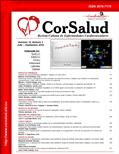Implantation of the cardioverter-defibrillator: Cuban Registry (2017)
Abstract
Introduction: The implantable cardioverter-defibrillator (ICD) has proven useful in the primary and secondary prevention of sudden cardiac death. The increase of its use motivates interest on its effectiveness outside the clinical trials. The first registration of an ICD implantation in Cuba is performed.
Objective: To know the current situation of an ICD implantation in Cuba, regarding clinical data, indication, type of implant, device and complications of the procedure.
Method: The registration’s data were obtained through the collection form, which was completed voluntarily by each implantation team during or after the implant.
Results: The total number of implants was 121, and the rate of 10.76 per million inhabitants. The procedure was performed in 5 medical institutions in the country, and 69.4% of the devices were implanted at the «Instituto de Cardiología y Cirugía Cardiovascular». The mean age was 58.05 ± 14.83, with a predominance of men (71.1%). The 52.1% were primo-implantation, dual-chamber devices represented 43.8% and triple-chamber 16.5%. In the primoimplants predominated patients with ejection fraction ≤35% (42.9%), in sinus rhythm (92.1%), with functional class III-IV (49.2%) and ischemic heart disease (41.3%). The 79.4% of the first implants were secondary prevention, and sudden death (42.9%), the most common clinical presentation. Complications were infrequent (4.1%) and the hematoma predominated.
Conclusions: The implantation rate of the ICD per million inhabitants is comparable with that of Latin American countries. The implants of triple-chamber systems and in primary prevention are still modest.
Downloads
References
1. The Antiarrhythmics versus Implantable Defibrillators (AVID) Investigators. A comparison of antiarrhythmic-drug therapy with implantable defibrillators in patients resuscitated from near-fatal ventricular arrhythmias. N Engl J Med. 1997;337(22):1576-83.
2. Connolly SJ, Gent M, Roberts RS, Dorian P, Roy D, Sheldon RS, et al. Canadian implantable defibrillator study (CIDS): A randomized trial of the implantable cardioverter defibrillator against amiodarone. Circulation. 2000;101(11):1297-302.
3. Kuck KH, Cappato R, Siebels J, Rüppel R. Randomized comparison of antiarrhythmic drug therapy with implantable defibrillators in patients resuscitated from cardiac arrest: the Cardiac Arrest Study Hamburg (CASH). Circulation. 2000;102(7):748-54.
4. Bardy GH, Lee KL, Mark DB, Poole JE, Packer DL, Boineau R, et al. Amiodarone or an implantable cardioverter-defibrillator for congestive heart failure. N Engl J Med. 2005;352(3):225-37.
5. Moss A, Zareba W, Hall WJ, Klein H, Wilber DJ, Cannom DS, et al. Prophylactic implantation of a defibrillator in patients with myocardial infarction and reduced ejection fraction. N Engl J Med. 2002;346(12):877-83.
6. Alzueta J, Fernández-Lozano I. Registro Español de Desfibrilador Automático Implantable. XIII Informe Oficial de la Sección de Electrofisiología y Arritmias de la Sociedad Española de Cardiología (2016). Rev Esp Cardiol. 2017;70(11):960-70.
7. Eucomed. Medical Technology Statistics for Cardiac Rhythm Management products, 2012-2016 [citado 6 Jul 2018]. Disponible en: http://www.medtecheurope.org
8. Dubner S, Valero E, Pesce R, Zuelgaray JG, Mateos JC, Filho SG, et al. A Latin American registry of implantable cardioverter defibrillators: the ICD-LABOR study. Ann Noninvasive Electrocardiol. 2005;10(4):420-8.
9. Narbondo F, Pouso J, Varela G, Calleriza F, Do Mato G, Reyes W. Cardiodesfibriladores implantables. Diecinueve años de experiencia en un centro de nuestro país. Rev Urug Cardiol. 2013;28(2):141-50.
10. Niemeijer MN, van den Berg ME, Leening MJ, Hofman A, Franco OH, Deckers JW, et al. Declining incidence of sudden cardiac death from 1990-2010 in a general middle-aged and elderly population: The Rotterdam Study. Heart Rhythm. 2015;12(1):123-9.
11. Eckart RE, Shry EA, Burke AP, McNear JA, Appel DA, Castillo-Rojas LM, et al. Sudden death in young adults: an autopsy-based series of a population undergoing active surveillance. J Am Coll Cardiol. 2011;58(12):1254-61.
12. Freeman JV, Wang Y, Curtis JP, Heidenreich PA, Hlatky MA. The relation between hospital procedure volume and complications of cardioverter-defibrillator implantation from the Implantable Cardioverter-Defibrillator Registry. J Am Coll Cardiol. 2010;56(14):1133-9.
13. Alzueta-Rodriguez J, Fernández-Pastor J, Ruiz-Salas A. Indicaciones y utilización del desfibrilador automático implantable ¿está infrautilizada esta terapia en nuestro medio? Cardiocore. 2015;50(3):115-8.
14. Arribas F, López-Gil M, Salguero R, Chimero J. Algunos aspectos relacionados con la implantación del desfibrilador automático implantable. Rev Esp Cardiol Supl. 2008;8(A):51-64.
15. Bristow MR, Saxon LA, Boehmer J, Krueger S, Kass DA, De Marco T,et al. Cardiac-resynchronization therapy with or without an implantable defibrillator in advanced chronic heart failure. N Engl J Med. 2004;350(21):2140-50.
16. Zipes DP, Camm AJ, Borggrefe M, Buxton AE, Chaitman B, Fromer M, et al. ACC/AHA/ESC 2006 guidelines for management of patients with ventricular arrhythmias and the prevention of sudden cardiac death – Executive summary: A report of the American College of Cardiology/American Heart Association Task Force and the European Society of Cardiology Committee for Practice Guidelines (Writing Committee to Develop Guidelines for Management of Patients with Ventricular Arrhythmias and the Prevention of Sudden Cardiac Death) Developed in collaboration with the European Heart Rhythm Association and the Heart Rhythm Society. Eur Heart J. 2006;27(17):2099-140.
17. Epstein AE, DiMarco JP, Ellenbogen KA, Estes NA, Freedman RA, Gettes LS, et al. ACC/AHA/HRS 2008 Guidelines for Device-Based Therapy of Cardiac Rhythm Abnormalities: a report of the American College of Cardiology/American Heart Association Task Force on Practice Guidelines (Writing Committee to Revise the ACC/AHA/NASPE 2002 Guideline Update for Implantation of Cardiac Pacemakers and Antiarrhythmia Devices) developed in collaboration with the American Association for Thoracic Surgery and Society of Thoracic Surgeons. J Am Coll Cardiol. 2008;51(21):e1-62.
Downloads
Published
How to Cite
Issue
Section
License
Authors who publish with this journal agree to the following terms:- Authors retain copyright and grant the journal right of first publication with the work simultaneously licensed under a Creative Commons Attribution License that allows others to share the work with an acknowledgement of the work's authorship and initial publication in this journal.
- Authors are able to enter into separate, additional contractual arrangements for the non-exclusive distribution of the journal's published version of the work (e.g., post it to an institutional repository or publish it in a book), with an acknowledgement of its initial publication in this journal.










